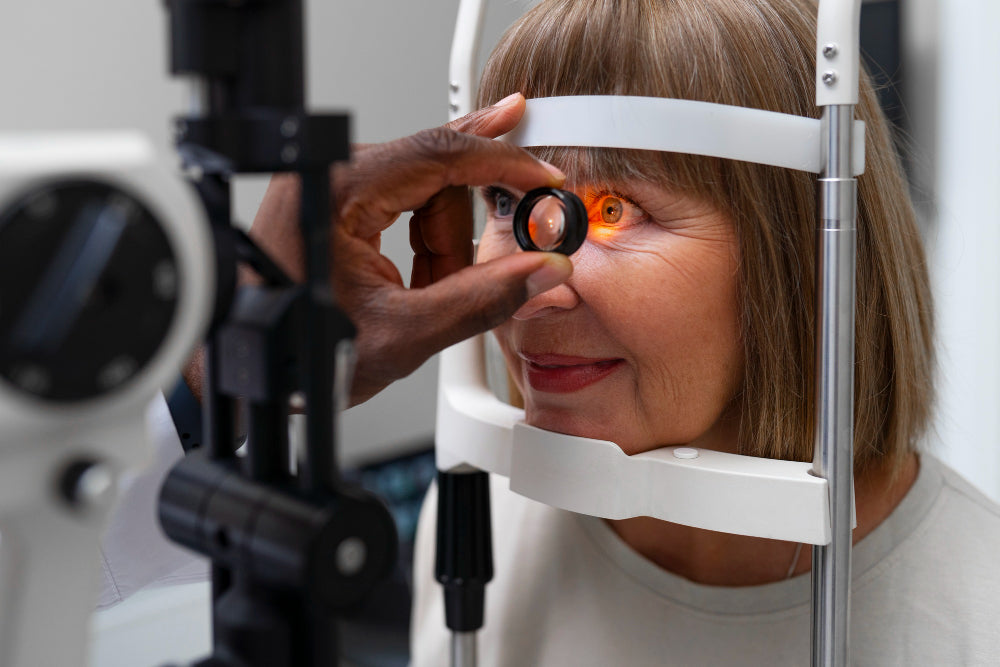Astigmatism affects millions, but did you know there's more than one type?
The key difference between regular and irregular astigmatism lies in the shape of the cornea. Regular astigmatism features a uniform curve, making corrections possible with standard glasses or contact lenses. In contrast, irregular astigmatism stems from uneven corneal surfaces caused by conditions like keratoconus or scarring, requiring specialized lenses for correction.
Are you curious about which type might be affecting your vision? Let's explore these two types of astigmatism and how you can achieve clearer sight with the right care.
What is Regular Astigmatism?
Regular astigmatism occurs when the cornea (the eye's clear front surface) has a consistent curvature but is shaped more like a football than a basketball. This means that one meridian (or axis) of the cornea is steeper than the other, leading to two different focal points in the eye.
As a result, individuals with regular astigmatism often experience blurred vision at all distances, difficulty seeing at night, and eye strain during the day.
Regular Astigmatism Example
- With-the-Rule Astigmatism: This common type of regular astigmatism occurs when the vertical meridian of the cornea is steeper than the horizontal meridian, resembling the natural curvature of a football lying on it’s side.
- Against-the-Rule Astigmatism: The horizontal meridian is steeper than the vertical, similar to a football standing upright.
- Oblique Astigmatism: This form of regular astigmatism occurs when the steepest and flattest meridians of the cornea are neither vertical nor horizontal but occur at an oblique angle.
Symptoms of Regular Astigmatism
- Blurred or distorted vision
- Difficulty seeing clearly at night
- Eye strain or discomfort
- Frequent headaches
Regular astigmatism can usually be corrected with prescription glasses or contact lenses specially designed to compensate for the uneven curvature of the cornea.
What is Irregular Astigmatism?
In contrast, irregular astigmatism occurs when the cornea has an uneven curvature that varies in multiple directions. This irregularity can result from conditions like keratoconus (a progressive thinning of the cornea) or after eye surgeries or corneal injuries.
The uneven shape causes light to scatter across multiple points on the retina instead of focusing on a single point, leading to more pronounced visual distortions.
Irregular Astigmatism Examples
- Keratoconus: A condition characterized by the gradual thinning and bulging of the cornea into a cone-like shape.
- Corneal Scarring: Scarring caused by injuries, infections, or surgeries that leave uneven scars on the cornea.
- Post-Surgical Complications: Irregular astigmatism can sometimes occur after procedures like LASIK or cataract surgery.
Symptoms of Irregular Astigmatism
- Severe distortion of vision
- Difficulty focusing on objects
- Increased sensitivity to light
- Frequent changes in prescription glasses
Types of Astigmatism: A Quick Overview
Astigmatism can be classified into several types based on its characteristics:
- Myopic Astigmatism: This happens when one or both principal meridians focus light in front of the retina.
- Hyperopic Astigmatism: This happens when one or both principal meridians focus light behind the retina.
- Mixed Astigmatism: In this case, one meridian is myopic while the other is hyperopic.
- Regular Astigmatism: Involves constant curvature in one direction.
- Irregular Astigmatism: Involves uneven curvature across multiple axes.
Understanding these types of astigmatism can help eye care professionals determine the best treatment options for patients.
Regular vs. Irregular Astigmatism: The Key Differences

To put it simply, the difference between regular and irregular astigmatism lies in the shape of the cornea and how light is focused:
|
Feature |
Regular Astigmatism |
Irregular Astigmatism |
|
Corneal Shape |
Uniform curvature along one axis |
Uneven, unpredictable curvature |
|
Cause |
Genetics, natural eye development |
Injury, disease (e.g., keratoconus), or surgery |
|
Correction |
Glasses, soft or RGP contact lenses for high astigmatism |
Specialized lenses (e.g., scleral lenses) |
|
Vision Distortion |
Mild to moderate |
Often severe and irregular |
How Are Regular and Irregular Astigmatism Diagnosed?
Diagnosis involves a comprehensive eye examination by an optometric physician. During this exam, various tests are conducted:
- Visual Acuity: Assesses how well you see at different distances.
- Keratometry: Measures the curvature of your cornea.
- Corneal Topography: Generates a topographical map of the cornea.
- Refraction: Identifies your exact prescription for glasses or contact lenses.
These tests can identify whether you have regular or irregular astigmatism and guide your eye care professional in recommending appropriate treatments.
Treatment Options for Astigmatism

Both regular and irregular astigmatism can be effectively managed with various treatment options:
For Regular Astigmatism
- Prescription Glasses: Lenses are crafted to counteract the specific curvature of your cornea.
- Contact Lenses: Soft toric lenses are often used for regular astigmatism, providing comfort and clear vision. High amounts of regular astigmatism may require rigid gas permeable contact lenses, or RGPs.
- Refractive Surgery: Procedures like LASIK can reshape the cornea to correct astigmatism permanently. However, patients with astigmatism are more likely to have trouble driving at night after LASIK.
For Irregular Astigmatism
- Scleral Lenses: These larger contact lenses vault over the cornea and provide a smooth optical surface for light to focus correctly.
- Corneal Cross-Linking: A procedure that strengthens corneal tissue in cases like keratoconus. Corneal Cross-Linking, while stabilizing the cornea to prevent further degradation does not improve the current visual outcome. It prevents the vision from becoming worse.
- Surgery: In severe cases, surgical options may be necessary to restore vision.
How Vision Source Rio Can Help
At Vision Source Rio, we pride ourselves on offering services that cater to a variety of eye care needs, including managing both regular and irregular astigmatism.
Services for Astigmatism:
- Comprehensive Eye Exams: Regular exams help detect conditions like astigmatism and keratoconus early, ensuring prompt, effective treatment.
- Specialized Contact Lenses: We provide custom-fitted scleral lenses for patients with irregular astigmatism that offer superior comfort and vision correction.
- Corneal Topography: Advanced diagnostic tools allow us to analyze the shape and health of your cornea with precision.
- Management of Eye Diseases: If your irregular astigmatism stems from conditions like keratoconus, our team offers tailored solutions to manage and treat these issues.
We aim to help you achieve your best possible vision while prioritizing your eye health.
Take the First Step Toward Clearer Vision
Whether you have regular or irregular astigmatism, there's no need to let blurry or distorted vision hold you back. With the right diagnosis and treatment plan, you can enjoy clearer, more comfortable vision.
If you're ready to take control of your eye health, schedule an appointment with Vision Source Rio today. Let us help you see the world more clearly, one step at a time.





